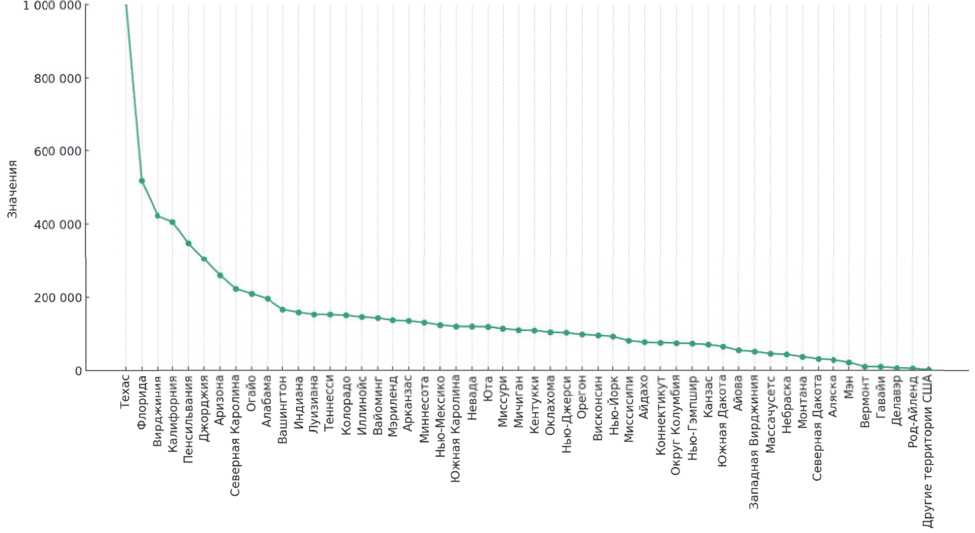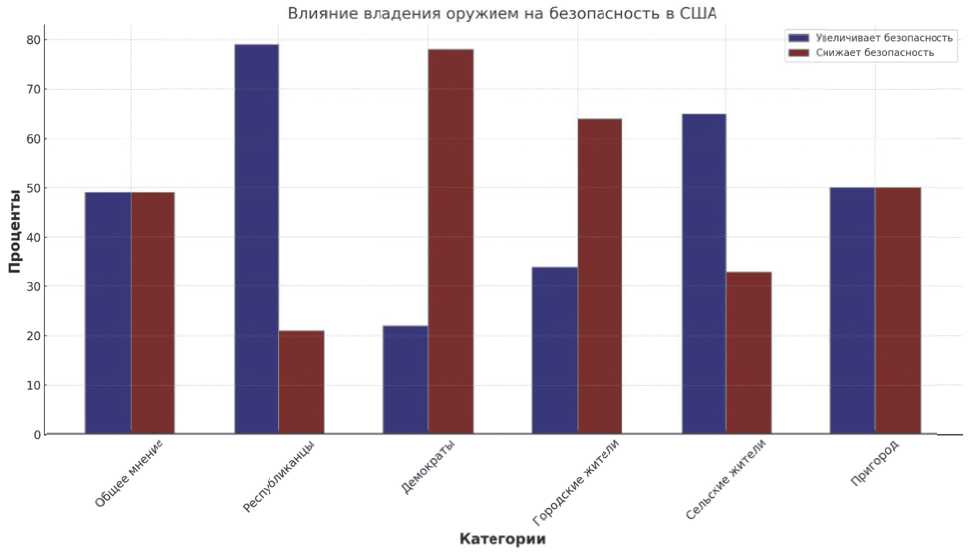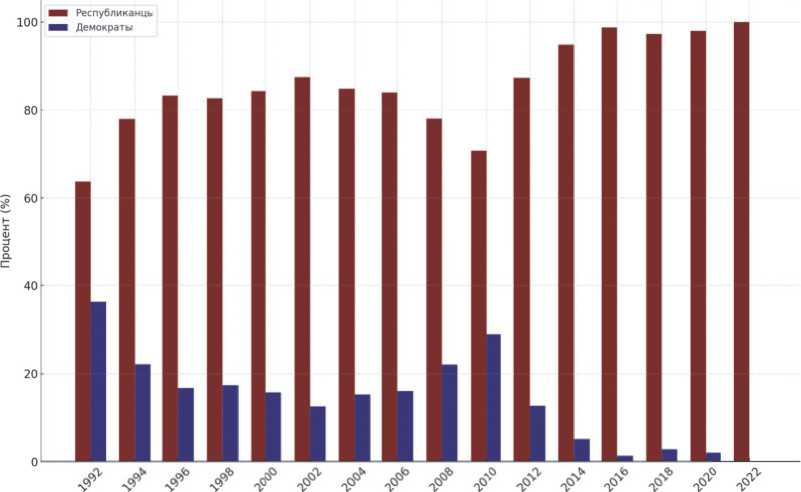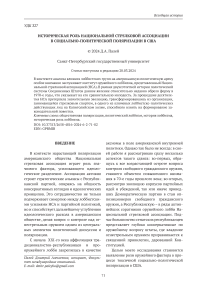Историческая роль национальной стрелковой ассоциации в социально-политической поляризации в США
Бесплатный доступ
В контексте анализа влияния лоббистских групп на американскую политическую арену особое внимание заслуживает институт оружейного лоббизма, представленный Национальной стрелковой ассоциацией (НСА). В рамках двухсотлетней истории политической системы Соединенных Штатов данное явление относительно недавно обрело форму в 1970-е годы, что указывает на его сравнительную молодость. За прошедшие десятилетия НСА претерпела значительную эволюцию, трансформировавшись из организации, занимающейся стрелковым спортом, в одного из ключевых лоббистско-политических действующих лиц на Капитолийском холме, способного влиять на формирование законодательной повестки.
Общественная поляризация, политический лоббизм, история лоббизма, историческая роль лоббизма
Короткий адрес: https://sciup.org/148328936
IDR: 148328936 | УДК: 327 | DOI: 10.37313/2658-4816-2024-6-2-71-82
Текст научной статьи Историческая роль национальной стрелковой ассоциации в социально-политической поляризации в США
В контексте нарастающей поляризации американского общества Национальная стрелковая ассоциация играет роль значимого фактора, усиливающего идеологическое разделение. Ассоциация активно строит стратегические альянсы с Республиканской партией, опираясь на общность консервативных взглядов и идеологических принципов. Это сотрудничество не только подчеркивает синергию между лоббистскими усилиями НСА и партийной политикой, но и способствует дальнейшему углублению идеологического раскола в американском обществе, делая вопрос о контроле над огнестрельным оружием одним из центральных элементов политической дискуссии и поляризации.
С начала XXI-го века аффилиация традиционалистов-республиканцев и про-оружейного лобби закрепилась в качестве
аксиомы в поле американской внутренней политики. Однако так было не всегда: в своей работе я рассматриваю сразу несколько аспектов такого сдвига: во-первых, обращусь к все возрастающей остроте вопроса контроля свободного гражданского оружия, ставшего объектом повышенного внимания в 70-е годы прошлого века; во-вторых, рассмотрю эволюцию корпусов партийных идей и убеждений, так или иначе приведших Демократическую партию в стан оппозиционеров свободного гражданского оружия, а Республиканскую – в ряды активнейших соратников оружейного лобби Национальной стрелковой ассоциации. Подчас большинство сенатских республиканцев представляет глубоко консервативные по оружейному вопросу штаты, где владение огнестрельным оружием приравнивается к священной привилегии, дарованной Конституцией.
Целью моего исследования становится выявление роли оружейного фактора в процессе токсичной социально-политической поляризации в США.
МЕТОДИКА
Рассматривая феномен американской социально-политической поляризации, я обращаюсь к теории социального конструктивизма, помогающей оперировать категориями и понятиями уровня воображаемых сообществ1 – национальных полюсов, мнящих себя отдельными частями американской нации; делящихся по исключительно идеологически-политическим убеждениям.
Следующим, не менее важным в данном исследовании подходом становится теория поляризации2 – радикализм обеих политических сторон начинает преобладать все в большей степени, увязывая партийную принадлежность и идеологическую приверженность; наряду с радикализацией либеральных и консервативных полюсов американского общества появляется беспрецедентно широкая прослойка колеблющихся центристов. Наряду с этим теоретическим подходом я обращаюсь к классической концепции социальной дис-танции3, проявляющейся во все возрастающем дистанцировании, перерастающем в социально-политическую ненависть внутри сообществ. Подобная ненависть в оппонирующей паре «республиканец-демократ» вызывается все более отчуждающими политическими повестками и сопровождающими их медийными кампаниями. В рамках произведенного исследования была проведена аналитическая работа с: а) рядом социологических опросов, опросов общественного мнения, фокус-групп; б) определенными кейсами лоббистско-законодательных инициатив; в) определенной частью законодательной базы, имеющей непосредственное отношение к оружейной проблематике в США; г) отчетно-статистическими данными лоббистских организаций.
РЕЗУЛЬТАТЫ И ОБСУЖДЕНИЕ
Последние несколько десятилетий, под влиянием дюжин факторов, сопровождают- ся все возрастающей поляризацией мнений и идеологических ценностей и убеждений внутри как самих партий, так и их последователей. Данная работа рассматривает феномен американской социально-политической поляризации через призму корпуса оружейно-правовых вопросов и проблема-тик, а также – партийных позиций и акционизма в этой сфере.
Политическая поляризация рассматривается как значимый фактор, ослабляющий основы демократии и ее принципы. В условиях повышенной поляризации общества электорат проявляет большую склонность к нарушению демократических норм в пользу партийных интересов, что может привести к деградации или коллапсу демократических институтов. Данный процесс особенно проявляется в периоды выборов, когда политические ставки максимально велики, а отступление от демократических стандартов во имя достижения партийных целей становится более оправданным4. Наличие прямой корреляции между уровнем политической поляризации и интенсификацией практик запугивания оппозиции со стороны государственных органов. Эта связь особенно выражена в демократических странах, что указывает на то, что поляризация способствует формированию недружелюбной атмосферы и стимулирует действующих политиков к применению антидемократических мер для удержания власти5.
В ситуации высокой поляризации власти могут эксплуатировать отсутствие достоверного избирательного наказания, манипулируя демократическими процессами в своих целях. Повышенная поляризация мотивирует электорат отдавать предпочтение партийным интересам перед демократическими ценностями, тем самым ослабляя функцию общества как сдерживающего фактора для авторитарных стремлений6.
Социально-политические процессы внутри современных США могут быть названы аффективной поляризацией, характеризующейся глубокими негативными эмоция- ми по отношению к оппозиции. Этот феномен способствует созданию политической среды, в которой граждане с большей вероятностью поддерживают антидемократические действия против соперничающих групп, дополнительно ослабляя демократическую структуру7.
Несмотря на обеспокоенность некоторых экспертов относительно отрицательного влияния поляризации на демократию, существуют исследования, указывающие на то, что поляризация может фактически способствовать улучшению процесса принятия решений избирателями за счет более четкого определения различий между партиями. Такой подход может вести к более осознанному голосованию, когда избиратели отдают предпочтение кандидатам, наилучшим образом отражающим их интересы, что потенциально улучшает демократическое представительство несмотря на усиление поляризации8.
Принцип избрания политических деятелей все больше склоняется к стороне токсичной и негативной партийной приверженности, в рамках которого американское общество выбирает по принципу наименьшего из двух зол. Идея традиционно колеблющихся штатов хоть и остается неизменной, теперь применима и к отдельно политико-географическим или социальногеографическим сферам и областям, определяя в центристские и умеренные группы порядка 46% голосующего населения США, демонстрирующих негативную партийную приверженность9. В свою очередь, на гипотетическом уровне подобная неудовлетворенность политическими повестками обеих партий высвобождает пространство для появления третьей политической силы в виде новой партии, построенной на принципе балансирования между двумя крайне полярными демократическими и республиканскими корпусами идей и убеждений. Примером похожего тектонического сдвига партийно-политического ландшафта США станет Southern Realignment, произошедший в середине ХХ века, системно изменивший партийные предпочтения Юга США, традиционно поддерживавшего Демократическую партию с момента окончания Гражданской войны, вплоть до 1960-х годов, трансформировавшись в уже привычную и аксиоматичную парадигму Республиканского юга. В течение ХХ века партии видоизменяли свои политические повестки, идеологически меняясь местами, в частности – в сферах экономического этатизма и социальных вопросов. Республиканская партия в этом изменении приняла более консервативную позицию, известную в настоящее время. Активно привлекая избирателя-южанина, республиканцы сфокусировались на консервативно ориентированных ценностях – расовых и федеративных вопросах.
Тем не менее подобная тенденция хоть и оформляется – еще не вызрела в полной мере: американское сообщество сходится во мнении о раздробленности и отчужденности, но опция третьей силы, оперирующей в политико-законотворческой сфере, не рассматривается всерьез, занимая одну из последних позиций в рамках всенационального опроса общественного мнения о наибольших угрозах демократическому устройству. Так, этот вопрос оценивается лишь в 5.3/10; к примеру, политические поляризация и отчужденность в том же опросе занимают второе по актуальности место с оценкой в 7.3/1010. Доводом в пользу все растущей обеспокоенности о появлении третьей партии предстает крайне высокое количество независимых избирателей – колеблющихся. Достигнув отметки в 42% в конце 2021 года, избиратели-индепенден-ты закрепились в качестве доминирующей электорально-политической силы. К настоящему моменту двум партиям удается перетягивать этот электорат в категорию клонящихся (leaning) – практически поровну: 17% за Демократической и 16% за Республиканской партией. Так, с 1988 года традиционно не превышающая порог в 36% группа избирателей-индепендентов активно растет, превышая отметку в 40% в ходе десятилетия 2011-2021 гг.11.
Одним из вопросов государственного регулирования в настоящее время предстает контроль над гражданским огнестрельным оружием. Опираясь на подобную ретроспективную практику, я обращаюсь к цепочке событий, происходивших немногим позднее, – Республиканскому повороту в оружейной повестке; фокусированию лоббистско-политических усилий Национальной стрелковой ассоциации именно на представителях Республиканской партии, тем самым отбрасывая точки какого-либо межпартийного диалога по вопросу контроля вооружений и лишь укрепляя социальнополитическую поляризацию.
Проблема партийного раскола в американском обществе, особенно в отношении контроля над огнестрельным оружием, отражает более широкий феномен того, как социальные разногласия влияют на политический выбор и партийные позиции. Исследования показывают, что изменения в политических позициях партий могут повлиять на взаимосвязь между социальными разногласиями и поведением избирателей, при этом влияние социальных разногласий будет преобладать после того, как эти изменения будут учтены12. Более того, разделенный партийный контроль над исполнительной и законодательной ветвями власти, который традиционно рассматривается как способствующий тупику и параличу политики, при определенных условиях может фактически способствовать принятию законодательства, что указывает на сложную взаимосвязь между партийной конкуренцией, результатами принятия политических решений и социальными расколами13.
Политические партии играют решающую роль в формировании социального раскола, активно создавая, а не просто отражая социальные разногласия. Эта конструктивная роль имеет решающее значение в создании и воспроизводстве социального раскола, демонстрируя значительное влияние партий на социальные разногласия, гегемонию и в конечном итоге на политические предпочтения, в том числе связанные
-
с контролем над оружием14.
Глубокий межпартийный раскол в вопросе контроля над оружием в Америке можно рассматривать как проявление этой более широкой динамики, когда политические партии не только отражают, но также формируют и усиливают социальные разногласия, что приводит к резко контрастирующим политическим позициям, которые отражают и усиливают основные социальные расколы внутри Америки.
В эволюции коалиций Республиканской и Демократической партий в США произошли значительные изменения: Республиканская партия все чаще становится аттрактором для групп, адвокатирующих интересы бизнеса и социально консервативных групп. Эта перегруппировка также привела к тому, что группы интересов, в том числе оружейное лобби, стали более тесно сотрудничать с Республиканской партией из-за общих идеологических целей, особенно в отношении прав на оружие и противодействия мерам контроля над огнестрельным оружием. Этот сдвиг является частью более широкой трансформации, в ходе которой Демократическая партия все чаще обращается к социальным либералам и потенциально про-бизнес-сегментам, которые выступают за более строгую политику контроля над оружием15.
Дебаты о контроле над огнестрельным оружием в США были отмечены значительными различиями в политических рамках и политической культуре между двумя основными партиями. Появление и успех анти-оружейных коалиций и законодательства в других странах, таких как Канада, контрастируют с Соединенными Штатами, где оружейное лобби, более тесно связанное с Республиканской партией, эффективно выступает против строгих мер по контролю над оружием. Эта разница подчеркивает уникальный политический и культурный контекст дебатов о контроле над оружием в США16.
Разумеется, вопрос огнестрельного оружия не выступает центральным, как не выступает ни одна из социально-полити- ческих проблемных повесток, но в рамках взаимозависимости социальных институтов – он является своего рода индикатором, определяющим направленность политической мысли, идейной приверженности и морального компаса различных социальных групп. Говоря о социальных группах, в своей работе я прослеживаю динамические социальные показатели:
-
А) процент владения оружием среди граждан США;
Б) демографическое соотношение владеющих огнестрельным оружием;
-
В) партийную принадлежность владеющих оружием;
Г) лоббистско-финансовую поддержу политических партий со стороны НСА.
Эти четыре критерия представляют собой процесс фильтрации с тем, чтобы в результате определить про-оружейную, консервативную и республикански-клоня-щуюся социальную группу. Наряду с этим помогают просмотреть общеполяризационные тренды с закреплением группы ин-депендентов, балансирующих между все более и более поляризованными Республиканской и Демократической партиями.
В первую очередь, мой анализ фокусируется на оценке общего процента владения оружием, используя метрику, основанную на соотношении между количеством зарегистрированных огнестрельных единиц и населением штата. Согласно данным Statista от 2021 года17, штаты Техас, Флорида и Вирджиния были идентифицированы как регионы с наивысшим уровнем распространения оружия. Напротив, Гавайи, Делавэр и Род-Айленд демонстрируют минимальные показатели владения огнестрельным оружием на душу населения. Интересно, что Техас и Флорида, относящиеся к числу наиболее населенных штатов, также выделяются своей либеральной оружейной политикой и принадлежностью к республиканским штатам. Вирджиния, в свою очередь, которая ранее склонялась в сторону Демократической партии, в последние годы классифицируется как штат с колеблющимся политическим предпочтением. В целом штаты с наименьшим уровнем владения огнестрельным оружием характеризуются как регионы с традиционной приверженностью к Демократической партии (см. график 1).
Значения по штатам

График 1. Количество американских граждан с открытыми лицензиями на владение оружием 18
Изменение демографии и растущая поляризация в США способствовали перегруппировке партийных коалиций: Республиканская партия привлекла больше белых избирателей через выстраивание таргетированной повестки по ряду социальных, расовых и идентичностных вопросов; одним из таких треков считается оружейный вопрос19. На этот сдвиг влияют идеологические расхождения и демографические изменения, которые подталкивают Демократическую партию к принятию политики, которая воспринимается как более либеральная, в том числе в отношении контроля над оружием, тем самым отталкивая консервативных белых избирателей, которые могут быстрее согласиться с позицией Республиканской партии в отношении прав на оружие20 (см. график 2).
Переориентация поддержки в пользу партий, традиционно считающихся «белыми», была обусловлена двумя ключевыми факторами. Во-первых, усиление поляризации на уровне политических элит способствовало укреплению идеологических предпочтений в массовом сознании как значимых предикторов электоральной под- держки. Обширная эмпирическая база подтверждает, что рост идеологической поляризации среди элит по ряду экономических, социальных и расовых вопросов инициировал процесс «сортировки» в обществе22, в ходе которого индивидуумы стали более осознанно идентифицировать себя с партией, наилучшим образом отражающей их политические убеждения, и отдавать за нее свои голоса23. Я утверждаю, что данный процесс способствовал миграции многих умеренных и консервативных белых из Демократической партии в Республиканскую партию, которая стала идеологически более созвучной их взглядам. Во-вторых, изменения в демографической структуре населения также оказали влияние. Этнические и расовые меньшинства, имеющие политические предпочтения, отличные от тех, что присущи белому населению, как в экономической, так и в социальной сферах, составляют постоянно растущую часть электората. Рост доли населения цветных по отношению к белому населению привел к сдвигу медианных электоральных предпочтений от тех, что были характерны для белого на-селения24. В ответ на эти демографические

График 2. Разделение мнений по вопросу безопасности/опасности свободного владения огнестрельным оружием. Составлено на основе работы Дж. Зингера 21 .
Финансирование политических партий от Национальной стрелковой ассоциации (1992-2022)

ГОД
График 3. Изменение политической ориентации Национальной стрелковой ассоциации в отношении поддержки республиканцев и демократов в период с 1992 г. по 2022 гг. 25
сдвиги позиционирование Демократической партии еще более отдалилось от позиций, традиционно поддерживаемых белым населением. В результате белые избиратели стали более склонны оказывать поддержку Республиканской партии (см. график 3). Предполагаю, что у граждан-индивидуумов присутствует устойчивое мнение о желаемом уровне этатизма в экономической и социальной сферах. Подобные ориентации оказывают значительное влияние на формирование партийных предпочтений и избирательного поведения.
Отдельного внимания заслуживает краткое рассмотрение позиций американских президентов относительно Второй поправки и гражданского огнестрельного оружия. Фокусируясь на второй половине 90-х годов ХХ века, необходимо отметить позицию Билла Клинтона и его администрации. Согласно этой позиции, Вторая поправка являлась неотъемлемой частью американского общества, однако акцент в поддержке ставился исключительно на спортивноохотничье использование оружия, иными словами – в рекреационных целях, тем не менее, как президент, так и его администра- ция поддержали Закон Брэди27. Администрация президента Буша, как и сам президент, имели более широкие и либеральные про-оружейные взгляды, однако стояли на необходимости проверки личностей и биографических данных как владельцев, так и желающих приобрести огнестрельное оружие28. На срок правления президента Обамы и его администрации выпала серия громких и трагичных массшутингов в ряде школ, что отразилось на принятии про-контролирующего и антиоружейного нарратива29. Президентство крайне консервативного и про-оружейного Дональда Трампа и его администрации сформировало, пусть и на короткий период, мощный про-оружейный дискурс. Такая поддержка, вкратце, обусловлена двумя факторами. Во-первых, президент Трамп сам является членом Национальной стрелковой ассоциации, а во-вторых, наряду с Миттом Ромни является рекордсменом среди политиков-реципиентов лоббистских средств, полученных от Ассоциации во время избирательной кампании30. Нынешний президент, Джо Байден, как и его администрация, в рамках традиций Демократической партии исхо-
Табл. 1. Отражает изменение политической ориентации Национальной стрелковой ассоциации в отношении поддержки республиканцев и демократов в период с 1992 по 2022 гг. 26
|
Год |
Процент поддержки республиканцев |
Процент поддержки демократов |
|
1992 |
63.72% |
36.28% |
|
1994 |
77.86% |
22.14% |
|
1996 |
83.41% |
16.59% |
|
1998 |
82.76% |
17.24% |
|
2000 |
84.40% |
15.60% |
|
2002 |
87.58% |
12.22% |
|
2004 |
84.92% |
15.08% |
|
2006 |
84.09% |
15.91% |
|
2008 |
77.93% |
22.07% |
|
2010 |
70.64% |
28.99% |
|
2012 |
87.44% |
12.56% |
|
2014 |
94.95% |
5.05% |
|
2016 |
98.74% |
1.26% |
|
2018 |
97.27% |
2.73% |
|
2020 |
97.99% |
1.97% |
|
2022 |
100.00% |
0.00% |
дят из крайне антиоружейной и проконтролирующей повестки, ратуя за ужесточение мер контроля, запрет любого штурмового оружия в гражданском пользовании, введение еще более строгих мер оружейного контроля, обязательства бороться с огнестрельно-оружейным насилием отражены в политической программе президента31.
ЗАКЛЮЧЕНИЕ
Влияние лоббирования на поляризацию дебатов по вопросам оружейной политики, особенно в контексте деятельности таких организаций, как Национальная стрелковая ассоциация (NRA) и Handgun Control, Inc., ныне - Кампания Брейди по предотвращению насилия с применением огнестрельного оружия, иллюстрирует значительное воздействие групп интересов на формирование американской политической повестки. Эти организации активно оперируют своими финансовыми, медийными и социально-электоральными ресурсами в рамках лоббистско-политической деятельности, влияя на процессы принятия политических решений, тем самым отражая идеологические предпочтения политических партий. Национальная стрелковая ассоциация, в частности, демонстрирует высокую эффективность в мобилизации законодателей от Республиканской партии, выступая за права на владение оружием. Путем предоставления целевых финансовых вкладов – спонсорства, NRA укрепляет обязательства этих законодателей противодействовать инициативам по контролю за огнестрельным оружием, тем самым создавая надежную базу для законодательной поддержки про-оружейной повестки. Данная стратегия не только усиливает про-оружейные позиции в Республиканской партии, но и вносит вклад в более обширную поляризацию дебатов по оружейной политике в Конгрессе. Деятельность Национальной стрелковой ассоциации укрепляет представление о влиянии лоббистских инициатив наряду с финансовыми вливаниями в определении законодательных исходов и изменений в партийно-политическом ландшафте, в особенности – в рамках крайне противоречивых социальных вопросов.
С другой стороны, организации, выступающие за контроль над огнестрельным оружием, такие как Handgun Control, Inc., концентрируют свои усилия на поддержке законодателей, выступающих за ужесточение контроля над оружием, преимущественно в стане Демократической партии. Лоббируя и финансируя кандидатов, поддерживающих строгий контроль над огнестрельным оружием, эти группы стремятся противостоять влиянию оружейного лобби и продвигать политику, направленную на снижение уровня огнестрельного насилия. Их активность отражает критическую роль групп интересов в адвокации политических изменений и мобилизации поддержки среди законодателей, разделяющих их политические цели. Участие данных групп в законодательном процессе подчеркивает спорный характер дебатов по оружейной политике и роль лоббирования в усилении поляризации в данной области.
Таким образом, динамика между лоббистскими группами, выступающими за и против контроля над огнестрельным оружием, служит ярким примером того, как лоббистская деятельность может формировать и усугублять политическую поляризацию32. Эти группы воздействуют на политические процессы не только через финансовые вклады и лоббирование законодателей, но и путем формирования общественного мнения через медиакампании и активное участие в общественных дебатах. Взаимодействие с партийными элитами и избирателями усиливает поляризацию, превращая вопросы контроля над оружием в один из центральных и наиболее спорных аспектов американской политики. Важность этой динамики не может быть переоценена, поскольку она влияет на способность политической системы достигать компромиссов и реализовывать эффективные политические решения. Поляризация, усиленная лоббистскими стараниями, ограничивает возможности для диалога и сотрудничества между партиями, что в свою очередь препятствует разработке и внедрению законодательства, которое могло бы адресовать коренные причины насилия с применением огнестрельного оружия, а также защитить права граждан на владение оружием в рамках разумных и безопасных ограничений. Кроме того, эта ситуация подчеркивает роль и ответственность групп интересов в поддержании здоровой демократии. В то время как лоббирование является легитимным и важным элементом демократического процесса, его влияние на поляризацию требует внимательного рассмотрения и потенциальной регуляции, чтобы процессы принятия решений оставались открытыми, прозрачными и справедливыми. Дебаты по оружейной политике в Соединенных Штатах являются зеркалом более широкой проблемы политической поляризации, усугубляемой лоббистскими группами. Это представляет собой вызов для американской политической системы в целом, требующий осмысленных усилий со стороны всех сторон для поиска общего языка и разработки компромиссных решений, которые служат интересам всего общества.
ПРИМЕЧАНИЯ
ELECTSTUD.2019.102048.
-
9 Is this The Third Party Moment? // Citizen Data.
URL:
Список литературы Историческая роль национальной стрелковой ассоциации в социально-политической поляризации в США
- Anderson B. Imagined Communities: Refl ections on the Origin and Spread of Nationalism. London: Verso, 1983, 256.
- Arbatli E., Rosenberg D. (2020). United we stand, divided we rule: how political polarization erodes democracy. // Democratization, 28, 285 - 307. https://doi.org/10.1080/13510347.2020.1818068.
- Bogardus E. S. (1933). A social distance scale. // Sociology & Social Research, 17, 265–271.
- Conlan T. (1991). Competitive Government in the United States: Policy Promotion and Divided Party Control. // Governance, 4, 403-419. https://doi.org/10.1111/J.1468-0491.1991.TB00021.X.
- Elff M. (2009). Social divisions, party positions, and electoral behaviour. // Electoral Studies, 28, 297-308. https://doi.org/10.1016/J. ELECTSTUD.2009.02.002.
- Fleming A., McLean D., Tatalovich R. (2018). Debating Gun Control in Canada and the United States: Divergent Policy Frames and Political Cultures.// World Affairs, 181, 348 - 371. https://doi.org/10.1177/0043820018812609.
- Green Donald P., Bradley Palmquist, and Eric Shickler. 2002. Partisan Hearts and Minds: Political Parties and the Social Identities of Voters. // New Haven, CT: Yale University Press
- Iyengar S., Sood G., Lelkes Y. (2012). Affect, Not Ideology A Social Identity Perspective on Polarization. // Public Opinion Quarterly, 76, 405-431. https://doi.org/10.1093/POQ/NFS038.
- Kingzette J., Druckman J., Klar S., Krupnikov Y., Levendusky M., Ryan J. (2021). How affective polarization undermines support for democratic norms. // Public Opinion Quarterly. https://doi.org/10.1093/POQ/NFAB029.
- Leon C., Desai M., Tuğa, C. (2009). Political Articulation: Parties and the Constitution of Cleavages in the United States, India, and Turkey*. // Sociological Theory, 27, 193 - 219. https://doi.org/10.1111/j.1467-9558.2009.01345.x.
- Levendusky Matthew. 2010. “Clearer Cues, More Consistent Voters: A Benefi t of Elite Polarization.” // Political Behavior 32 (1): 111–31.
- Miller G., Schofi eld N. (2008). The Transformation of the Republican and Democratic Party Coalitions in the U.S.. // Perspectives on Politics, 6, 433 - 450. https://doi.org/10.1017/S1537592708081218
- Paley, D.A. US NATIONAL RIFLE ASSOCIATION LOBBYING: PAST AND PRESENT/ D. A. Paley, N.A. Tsvetkova // History and modern worldview. – 2021. – T. 3, No. 2. – P. 25-31. – DOI 10.33693/2658-4654-2021-3-2-25-31. – EDN HUDYNV.
- Pierce D.,Lau, R. (2019). Polarization and correct voting in U.S. presidential elections. // Electoral Studies. https://doi.org/10.1016/J. ELECTSTUD.2019.102048.
- Smidt Corwin. 2017. “Polarization and the Decline of the American Floating Voter.” // American Journal of Political Science 61 (2): 365–81.
- Svolik M. (2018). When Polarization Trumps Civic Virtue: Partisan Confl ict and the Subversion of Democracy by Incumbents.Political Behavior: Voting & Public Opinion eJournal. https://doi.org/10.2139/ssrn.3243470.
- Svolik M. (2019). Polarization versus Democracy.Journal of Democracy, 30, 20 - 32. https://doi.org/10.1353/JOD.2019.0039.
- Zingher J. (2018). Polarization, Demographic Change, and White Flight from the Democratic Party. The Journal of Politics, 80, 860 - 872. https://doi.org/10.1086/696994.
- Notarangelo R. (2016). Hunting Down the Meaning of the Second Amendment: An American Right to Pursue Game.South Dakota law review, 61, 201.
- Hardaway R., Gormley E., Тaylor, B. (2002). The Inconvenient Militia Clause of the Second Amendment: Why the Supreme Court Declines to Resolve the Debate Over the Right to Bear Arms. Journal of Civil Rights and Economic Development, 16, 2.
- Meaux C. (2014). Attempted Infringement: The Founders, President Obama’s Gun Control Policies, and the Sacredness of the Second Amendment’s Fundamental Right to Keep and Bear Arms. https://doi.org/10.2139/SSRN.2397913.
- Paley D.A. Lobbying activities of the US National Rifl e Association: past and present / D. A. Paley, N. A. Tsvetkova // History and modern worldview. – 2021. – T. 3, No. 2. – P. 25-31. – DOI 10.33693/2658-4654-2021-3-2-25-31. – EDN HUDYNV.
- Raj A. (2020). Gun violence in the U.S.: It is past time we listen to the voices of women and black communities. EClinicalMedicine, 28. https://doi.org/10.1016/j.eclinm.2020.100610.
- Палей Д.А. Лоббистская деятельность национальной стрелковой ассоциации США: прошлое и настоящее / Д. А. Палей, Н. А. Цветкова // История и современное мировоззрение. 2021. Т. 3, № 2. – С. 25-31. – DOI 10.33693/2658-4654-2021-3-2-25-31. – EDN HUDYNV.


